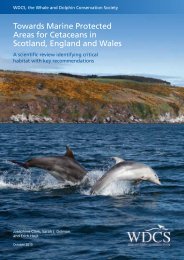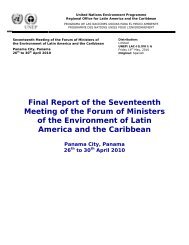Sea Turtle Recovery Action Plan for Barbados - WIDECAST
Sea Turtle Recovery Action Plan for Barbados - WIDECAST
Sea Turtle Recovery Action Plan for Barbados - WIDECAST
You also want an ePaper? Increase the reach of your titles
YUMPU automatically turns print PDFs into web optimized ePapers that Google loves.
<strong>Barbados</strong> <strong>Sea</strong> <strong>Turtle</strong>s …<br />
I. INTRODUCTION<br />
<strong>Barbados</strong> (59 o 35'W, 13 o 10'N) is the most easterly island in the Lesser Antilles (Map 1).<br />
Historical evidence suggests that turtles may never have been particularly common around<br />
<strong>Barbados</strong>. <strong>Turtle</strong> bones, dating back to about 1000 AD, have been found at only one of five<br />
Amerindian sites excavated in the country. By contrast, the bones of turtles are commonly found<br />
at Amerindian sites of a similar period in Antigua, as well as in St. Vincent and the Grenadines.<br />
Ligon (1673), in an account of the society, economy, and natural history of <strong>Barbados</strong> recorded<br />
during a stay between 1647 and 1650, mentions an abundance of green turtles (Chelonia mydas)<br />
in the Leeward Islands of the Caribbean. A lover of turtle meat, he was disappointed that green<br />
turtles were so few around <strong>Barbados</strong>, and moreover that those present were neither "fat nor<br />
kindly". Perhaps the green turtles he encountered were immature, or perhaps he was misidentifying<br />
hawksbills as immature green turtles.<br />
Fresh green turtle meat was widely eaten in the Caribbean, and calipee especially was<br />
considered a delicacy in the Leeward Islands, at the time Ligon was writing. Yet the only turtle<br />
meat that was available in <strong>Barbados</strong> was pickled turtle meat imported from the Leeward islands.<br />
Ligon (1673) postulated that the lack of green turtles reflected the fact that there were no sandy<br />
beaches <strong>for</strong> turtles to nest on in <strong>Barbados</strong>. This is somewhat surprising, since one of the primary<br />
attractions of <strong>Barbados</strong> as a present day tourist destination is its white sandy beaches. Nearly<br />
two centuries later, Schomburgk (1848) included three species of sea turtle in the vertebrate<br />
fauna of <strong>Barbados</strong>: the hawksbill, green, and loggerhead sea turtles, archaically known as Caretta<br />
imbricata, Caretta esculenta, and Caretta cephalo, respectively. He made no mention of the<br />
distribution or abundance of these species, nor whether they nested on the island.<br />
Today, hawksbills and an occasional leatherback (Dermochelys coriacea) are the only<br />
species of sea turtle known to nest in <strong>Barbados</strong>. Hawksbills, loggerheads, and green turtles are<br />
all harvested (additional detail is provided in section 3.3). Hawksbills are primarily caught with<br />
the use of nets set between the outer edges of fringing reefs and the bank reef (1000 m offshore)<br />
off the west and south coasts. Juvenile green turtles are caught in similar nets set a few hundred<br />
yards from shore on the east coast. Adult greens and loggerheads are speared opportunistically<br />
by offshore pelagic fishermen whilst they wait <strong>for</strong> gill nets to fill. The meat, eggs, and shells of<br />
hawksbills are used, as well as (but more rarely) the meat and shells of green turtles, the meat of<br />
loggerheads, and the eggs of leatherbacks -- despite the fact that egg harvest is illegal at all times<br />
(section 4.21). <strong>Turtle</strong> shell articles such as jewelry and combs are on sale in numerous<br />
tourist-orientated shops. Although present legislation prohibits the possession of any turtle under<br />
30 lbs (13.6 kg), preserved and mounted juvenile hawksbills (generally

















